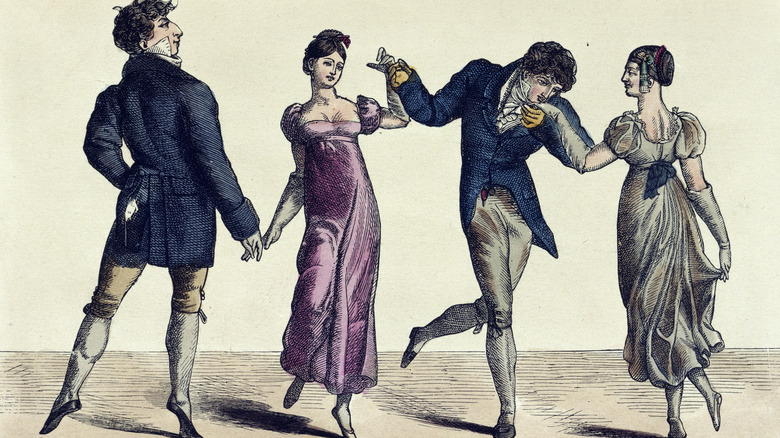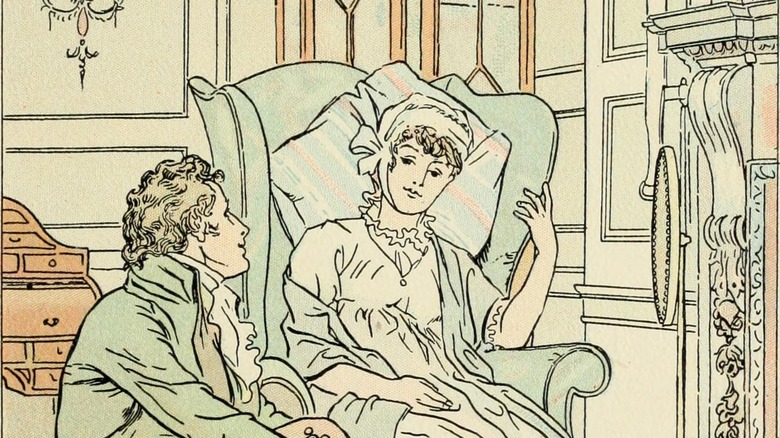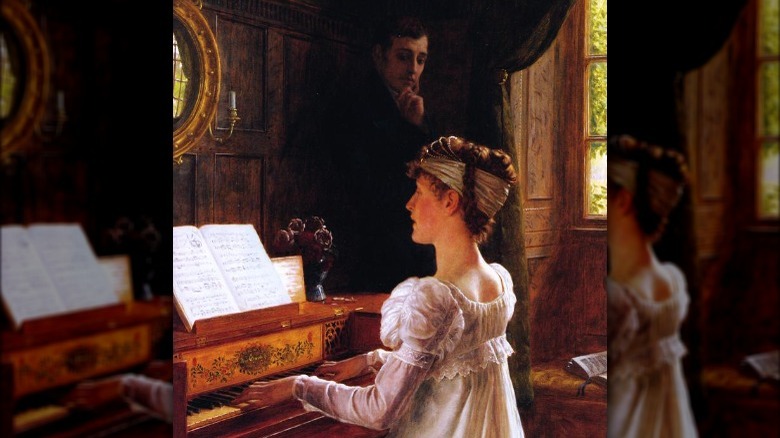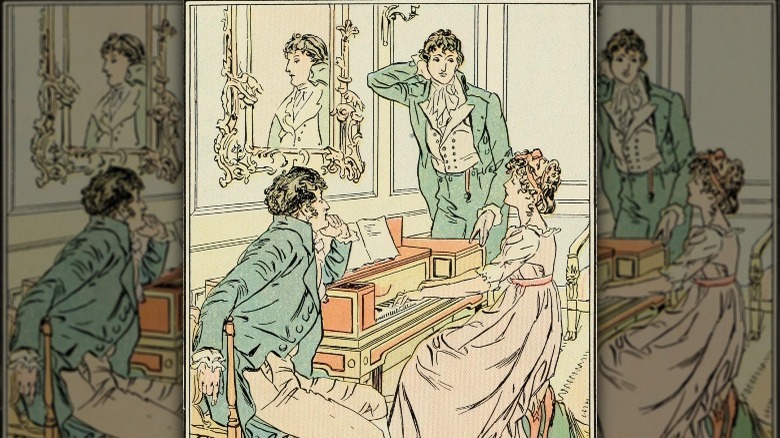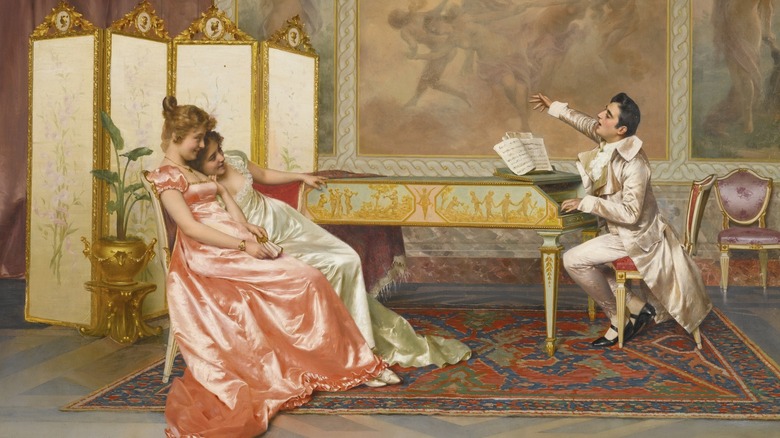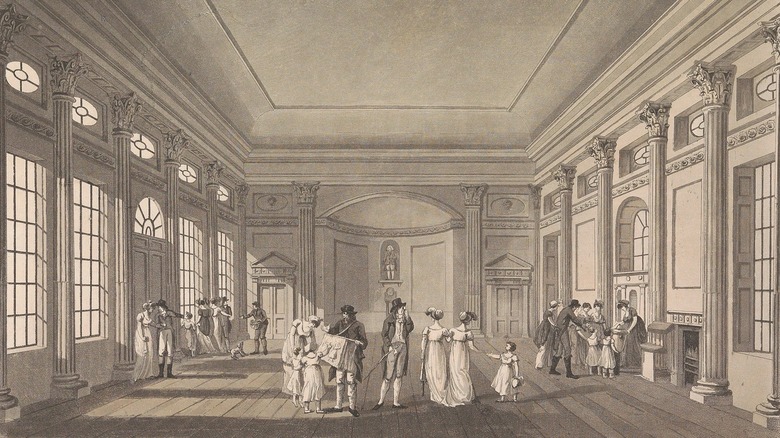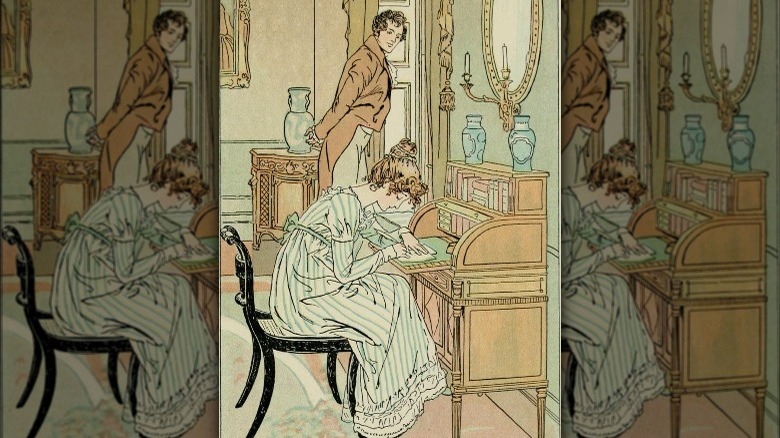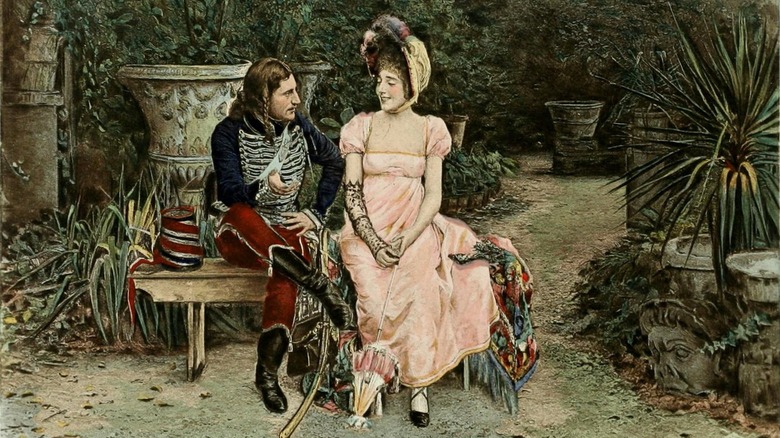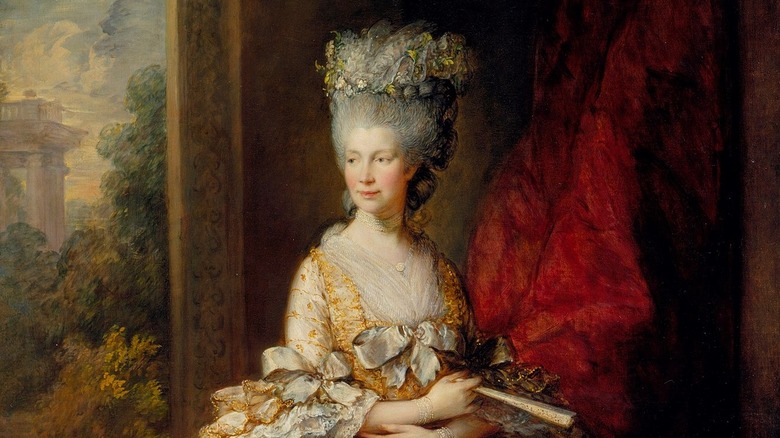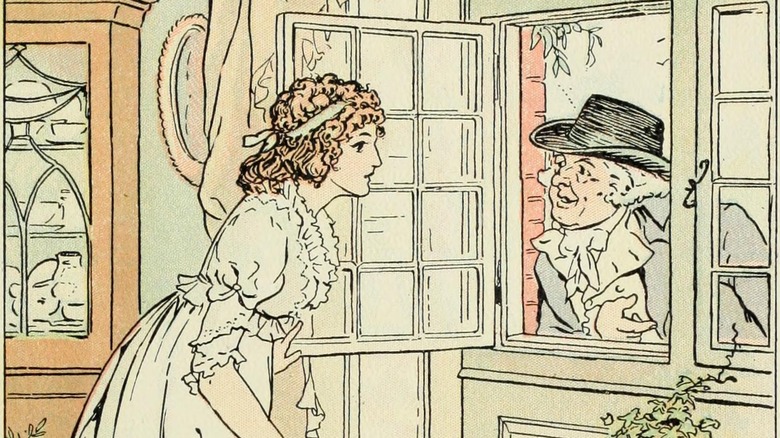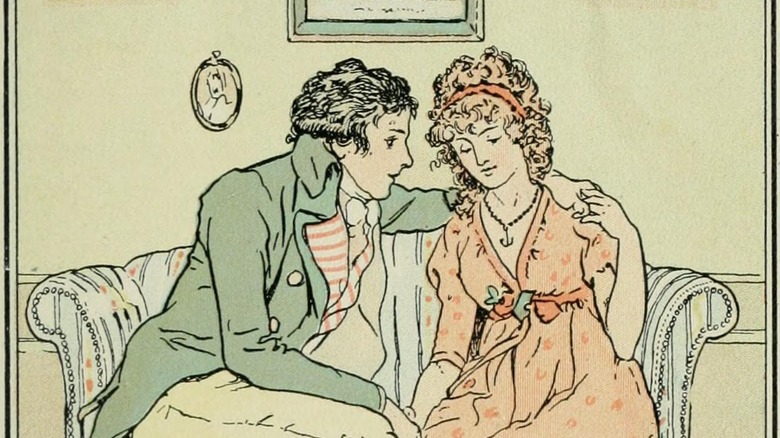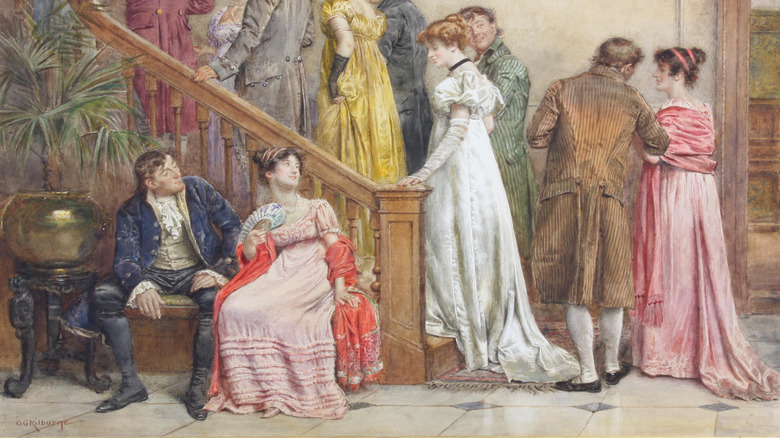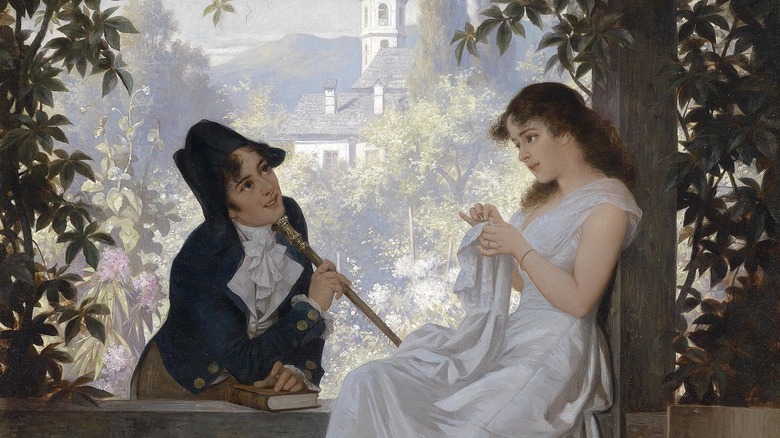How Aristocrats Found Spouses In Regency England
Finding a spouse can feel like a high-stakes situation at almost any time or place. You are looking for someone to pair up with for your entire life, after all. But few can compare to the all-or-nothing proposition that was a marriage in Regency England. Securing a wife or husband then wasn't just a matter of finding someone you liked, or even tracking down that ineffable spark so many people talk about nowadays.
If someone was in the higher classes, there was far more than romance on the line. Reputations could be boosted or torpedoed in the high-strung world of fine society, which could then have ripple effects on a family's social connections and business dealings. What's more, fortunes could be squandered by a poorly-chosen spouse. In a world where women's legal rights were almost entirely subjugated in favor of their husbands' or other male relatives' rights, that could have profound effects on everyone involved.
So, if someone was an attractive heiress or eligible moneyed bachelor in the early decades of the 19th century, how could they find a partner? What did they look for and just how did they go about it while maintaining a good image and keeping everyone involved as happy as possible? It's guaranteed to be far more complicated than a shallow romance novel will have you believe (though, of course, the wry and ever-observant Jane Austen was usually right on the money). Here's the truth of how aristocrats found spouses in Regency England.
Few expected to marry for love alone
Though finding an affectionate spouse was a consideration for Regency aristocrats, getting married was not entirely about going all heart-eyes at each other forever and ever. As in so many other times and societies, the people of Regency England recognized that marriage was also a binding legal and social contract. Getting all lovey-dovey could be a serious impediment, especially when you were a well-off young person with a lot to lose in a bad marriage.
To do well, you had to tread carefully and not get too emotional about things. People who were overly focused on love could find themselves in dire straits in an unforgiving system. Consider Lydia Bennett, the younger Bennett sister from Jane Austen's "Pride and Prejudice." She marries the irresponsible George Wickham for love (or what Austen and the readers likely see more like lust) and then pays for it by being stuck with the tricky Wickham for life (via The Atlantic).
As a result of all this, potential spouses often had to come up against a laundry list of unglamorous requirements, as History Extra notes. Could they produce heirs to take on the family holdings? Was a future spouse capable of managing their finances? Could they keep from embarrassing themselves at social events? What, exactly, could they bring to the union that would not only benefit their future spouse but the rest of the family, and even the social order?
Love and affection were still important in the Regency marriage
Though people could be eminently practical when it came to making a match, they also largely recognized that you still should at least like your spouse. For many people, even in aristocratic circles, romantic love was still part of the equation. After all, it's not as if people in Regency England were automatons who were completely devoid of emotion. They recognized that marriage was a deal meant for life. You might as well be happy, or at least content if you can manage it.
Even the older generation wasn't quite as cold-hearted as you might think, though aristocratic reputations and fortunes were still very definitely on the line. According to "A History of Courtship," a letter-writing manual that gave examples of letters and appropriate responses, a courtship proposal from a young man is referenced with the two possible replies from the lady's father. The positive reply includes a line that maintains that "in the marriage state, happiness consists only in reciprocal affection." Sure, it's no, "you had me at hello" (which would be strange coming from your beloved's dad anyway), but it's a clear sign that Regency people saw love as a good thing in marriage.
Women attracted a spouse by working on refined skills
What exactly made a young woman a good marriage prospect in the high tension world of the social season? To attract a proper mate, aristocratic young women were to be pretty innocuous and should know genteel skills like needlework, language (French was preferred), and music, as per History Extra. Few gentlemen, it seems, would be interested in anyone who was loud or had too much of a personality, at least in public. Quiet modesty was where it was at. Oh, and you should be young. Women, unfortunately, were considered to have something of an expiration date.
Actively pursuing a man was hardly in vogue, but passively putting oneself in a potential suitor's way was acceptable. Promenades became popular, wherein people would literally wander around in fashionable spots like parks and shopping areas, decked out in the hopes of catching someone's eye. According to the Jane Austen Centre, women with the resources for an expansive wardrobe would have multiple walking dresses appropriate to the season and to current fashion. It's clear that, after cultivating refined skills like playing the piano and saying pretty things in French, well off young women still had to put in the effort of being seen in their best lights, and by the best eligible bachelors as often as possible.
Aristocratic Regency men needed dance skills
While quite a lot of Regency society was weighted against women who wanted to have full control of their own lives and finances, it wasn't completely free and easy for the men. After all, when it came time to find a wife, aristocratic men typically had to put their best foot forward, too.
What did that look like, exactly? To be an attractive spouse, many upper-class Regency men had to learn refined skills like dancing, according to History Extra. It wouldn't do to be a non-dancing dud at the next ball (Mr. Darcy excepted, of course). They also had to demonstrate that they were intelligent, had a vigorous lifestyle full of sporting activities, and should be widely traveled, at least throughout the European continent.
"The Young Woman's Companion," an advice book published in 1815, gets pretty direct in its "Choice of Husband" section. A good future husband should be sober and prudent — no gambling matches full of gin for your intended, please. Neither should a sensible young woman want someone illiterate for a husband, nor the dreaded hedonist. These types would be too fickle or downright stupid to make for a happy wife and, given how a woman seemed blessed or doomed by her choice of husband, she'd better steer well clear of party boys and dolts. Instead, she should look for someone worthy of her respect who won't toy with the carefully laid rules of propriety.
Many Regency high rollers flocked to courting hubs
Aristocratic families had to pay heed to the social season, which took up half the year and was packed with social engagements like balls, performances, and more intimate dinners (via Los Angeles Times). The pressure could be immense, especially if the dating pool was limited to a certain social set. Even worse, many young ladies were expected to find someone within a single season. Returning for a second go-round the next year was considered embarrassing and could hurt someone's chances of finding a decent suitor. The nature of this pressure cooker-style environment could make things a bit mercenary, leading to the common term of the "marriage market."
Certain towns, like the spa town of Bath or the seaside resort of Brighton, were especially popular gathering spots for those with matrimony on their minds, according to "Dwindling into a Wife." Meanwhile, in London, there was a serious air of exclusivity at Almack's Assembly Rooms, overseen by high society patronesses. According to the Jane Austen Centre, these women held the immense power of deciding who was worthy enough to attend the assemblies. If they revoked someone's voucher (basically, a season pass), not only was that unfortunate out the 10 guineas it took to secure one, but they would become a social pariah. After all, you didn't get kicked out of Almack's for nothing. That would be an awfully suspicious black mark on your record when a potential spouse and their family entered your orbit.
Making your attentions known could take a few different forms
Telling the person you're interested in that you like them can be a pretty nerve-wracking affair. But while modern folks can get it over within a few words (or over a text, if you really insist on draining the sentiment out of the occasion), aristocratic Regency lovebirds had to navigate a whole set of ritualized practices to demonstrate their intentions.
As History Extra reports, that could be all manner of things, from gifts given to the lady to a chaperoned conversation or walk. It also often took the form of letters exchanged between the couple. Writers had to watch their language though because the letters weren't necessarily private. A finely tuned letter could really impress the family, while private exchanges of letters could look suspicious indeed. Dancing was also an even more public way of paying attention to a potential match, though suitors had to keep careful count. If a couple danced more than a couple dances together, they would have given the impression that the pair were engaged.
Few looked for matches outside of their class
For people of all social classes, the notion of making a match outside of one's station would have amounted to little more than a joke. Sure, a man might have a mistress from a lower class, as History Extra notes, but to legally entangle himself with her for the rest of their lives? No thanks. A higher-class woman would be more likely to bring a good dowry to the table, for one. This is, in part, how rich people maintained their wealth — by keeping it within their social circle and not redistributing their money outside of it.
Plus, marrying outside your class could be embarrassing. It might give someone the idea that they had the right to upset the social order and cause all sorts of vaguely defined chaos. History Extra notes that one vicar got pretty snooty about just such a thing when a servant married up by snagging a farmer's daughter. Perhaps he was especially sour because the young man was his servant. And a governess, writing in 1810, obliquely mentioned that a dairymaid who had entered into matrimony with the boss had suffered significant sorrow for the audacity of her match.
Some marriage-minded debutantes were presented at Queen Charlotte's ball
For young women who were moving in high society circles, going out into that society in the search for a suitable husband wasn't as easy as just showing up at the next party. Instead, it was all but required for some to go through yet another set of ritualized behaviors to demonstrate that they were ready for marriage. They were going to be debutantes.
In Regency England, that oftentimes required attendance at Queen Charlotte's Ball. By the 20th century, says History Extra, this was a codified coming out ritual where eligible young women were presented to the monarch. Beginning in 1780, Queen Charlotte's Ball was both a social and a charity event overseen by Queen Charlotte herself.
But why hold the ball in the first place? Essentially, the royal family found itself less often the subject of glowing accounts that presented them as divinely appointed rulers, and more likely fodder for satire and political cartoons. Having a mentally ill monarch — that would be "mad" George III, Charlotte's husband — and a licentious, profligate heir wasn't helping things. Charlotte's ball helped boost the family's image. It also reinforced the social season and helped aristocrats make matches with vetted young women who had debuted with the tacit approval of the queen herself.
Finding a marriage partner meant digging into finances
Failing to properly investigate a future husband's, or wife's, spending habits could set a marriage up for some seriously rough times. If we're being brutally honest, that's just as much of a consideration today as it was for Regency folks. Certainly, you don't want to be unpleasantly surprised by a new spouse's massive credit card debt that's suddenly become your problem too. In an era where marriage also reflected upon a whole family and not just the two individuals standing up at the altar, finding someone with good financial sense was all the more important.
According to Persuasions, the journal of the Jane Austen Society of North America, inheritance laws of the time often left women in precarious situations, financially speaking. Their best bet for stability was to find a spouse who both had money and knew how to handle it since the legal system was going to grant control to him anyway. The law effectively took all decision-making power away from women. Unless a woman was a rare heiress or Lady Catherine de Bourgh, menacing our main cast in "Pride and Prejudice," she could expect to be passed from father to husband like a piece of property, legally speaking. Making a careful choice of a financially prudent spouse was often an aristocratic young lady's easiest path to an agreeable married life.
Most Regency lovers kept things pretty chaste
For aristocratic wooers, it was vitally important to keep everything pre-marriage as inoffensive as they could stand. In a society where a reputation could make or break a critical match, staying chaste was a big deal.
Well, at least it was for the ladies. Like many things in Regency society, things were unfairly weighted in favor of the men, who could stand to have a down low dalliance or two without it completely ruining their marriage prospects. Certainly, it was a common practice for King George IV, reports the Los Angeles Times. Meanwhile, the lower classes could get plenty bawdy pre-marriage, meaning that it was really the young upper-class women who were often left in the dark about the facts of married life until their wedding night. During the courting phase, their primary virtues were supposed to encompass chastity and modesty. And with a chaperone dogging their every move (and perhaps the occasional scandalous example of what not to do), they had little motivation to deviate.
This emphasis on keeping everything above board was, in many ways, more about money and inheritance than a woman's virtue alone. Husbands would want some reassurance that their children — who stood to inherit everything — were really their children. As the journal Persuasions notes, having a child out of wedlock not only ruined one's social standing, but it created awkward legal situations that many families of eligible young folks just wanted to avoid.
Cousins weren't totally out of the equation
At this point, it's clear that aristocrats could have a tough time finding just the right spouse. They had to be of the correct social standing, of course. They had to have money and should know how to handle it so they don't torpedo two families' fortunes in a single generation. They should also be refined enough to impress everyone with their skills, be it the ability to rock it at the clavichord or to execute a fine turn in an allemande. Perhaps it's no wonder that some turned to people they knew could keep the money and reputation safely ensconced in the family — that is, their own family.
Now, don't get too appalled right away. Marriage between close relatives, such as a brother and sister, was very definitely illegal courtesy of the Marriage Act, as Persuasions reassures us. But the law wasn't quite so strict when it came to more removed branches of the family tree. Cousins were typically fair game. In-laws were still typically off the table, however, even though they weren't genetically related. If your spouse were to die and you then married their brother or sister, that union was on shaky legal ground. It could potentially be declared void and any children produced therein would be considered illegitimate and unceremoniously kicked out of the line of inheritance.
The average marriage age was higher than you think
The age of consent in Regency England sounds shockingly low to us now. According to "What Jane Austen Ate and Charles Dickens Knew," the age at which people could get married without parental permission began at 14 for boys and 12 for girls, starting in 1823.
However, just because someone could get married well before they hit their 20s doesn't mean they were all hitching the knot the moment they could. In fact, the real average age of marriage in Regency England for both men and women wasn't all that low. According to History, the end of the 18th century saw an average age at marriage of 28 for men and 26 for women. Now, that fell somewhat over the course of the next century, which included the Regency, but the average age of marriage for women remained firmly in the 20s. Even upper-class women, who tended to get married earlier than their plebeian counterparts, were still unlikely to be teenage brides.
Compare that to the average age of marriage in the United States today, which stands at about 28 for women and 30 for men (via Brides). A Regency person might look around with concern at the somewhat greater number of old maids and bachelors milling about, but it likely wouldn't have been all that shocking to them, aristocratic or otherwise.
